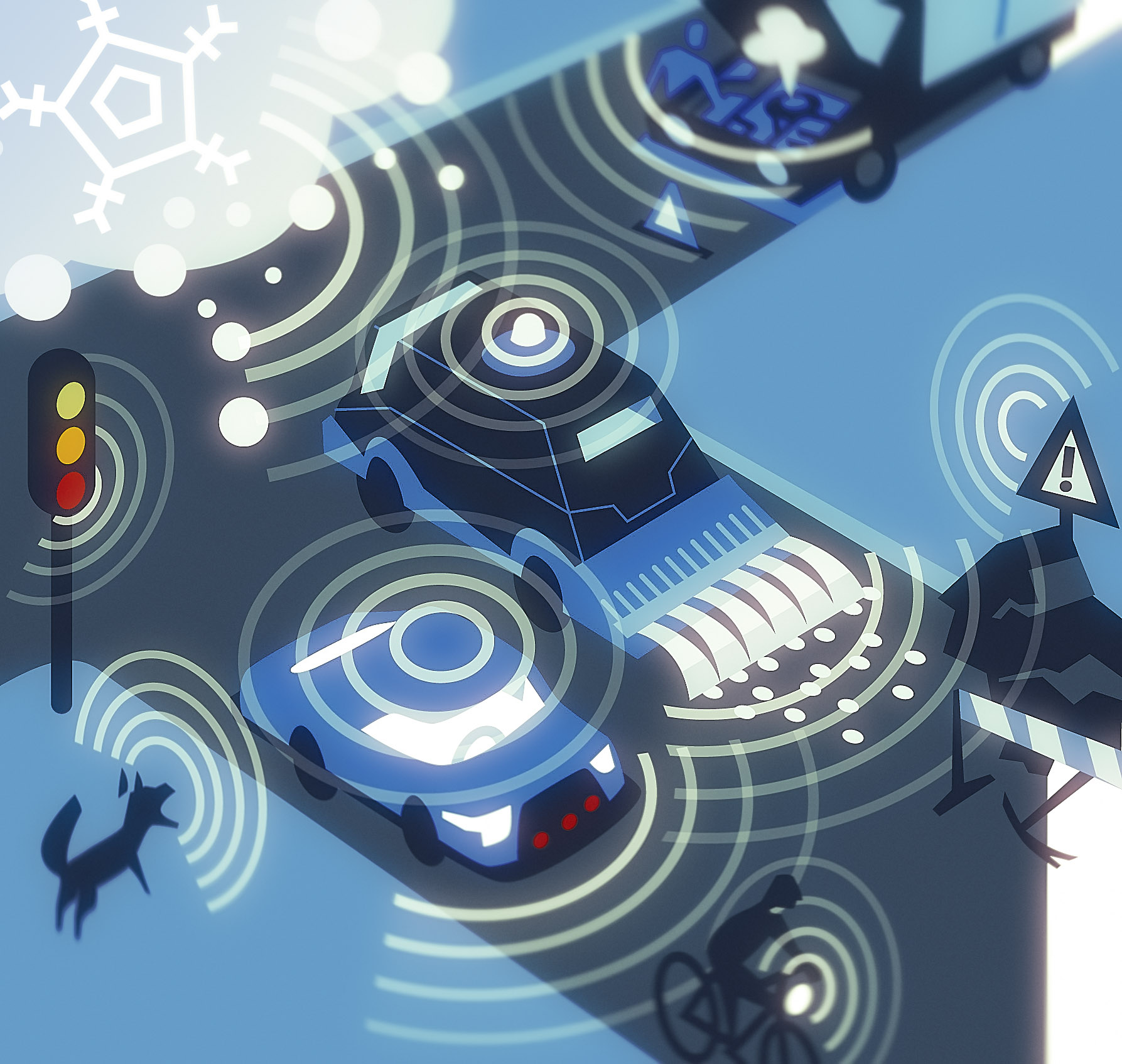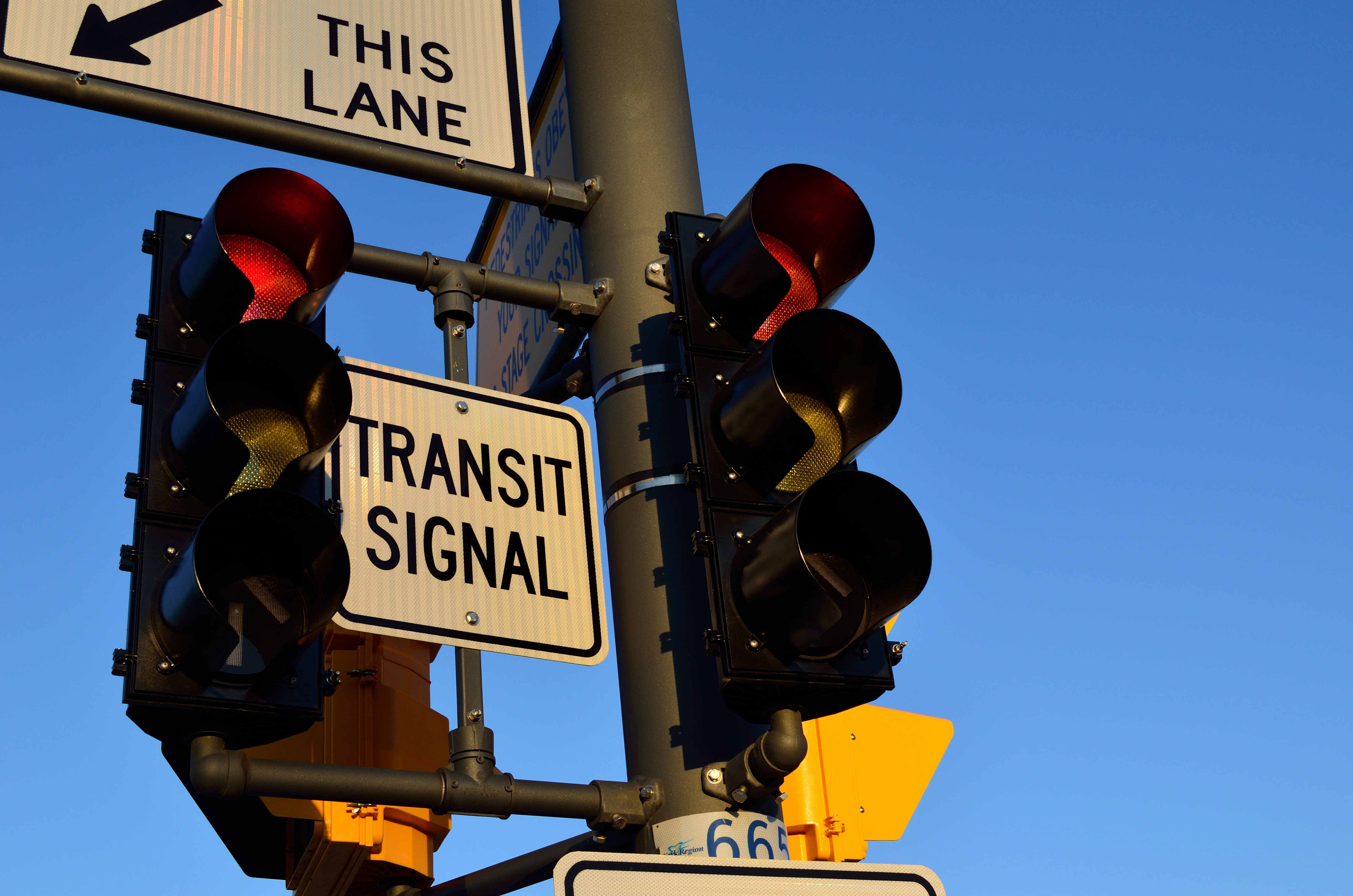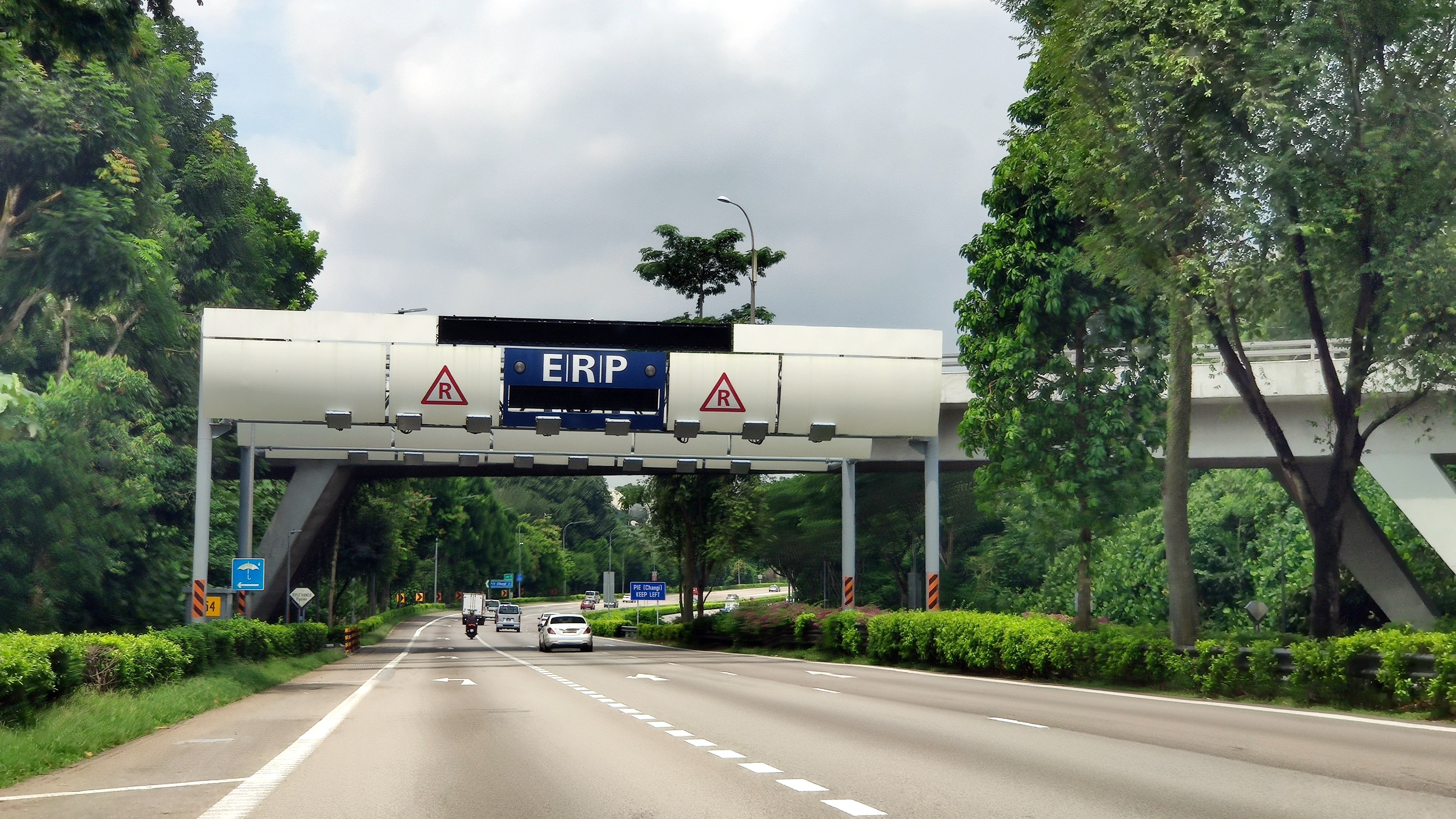|
Dedicated Short-range Communications
Dedicated short-range communications (DSRC) is a technology for direct wireless exchange of vehicle-to-everything (V2X) and other intelligent transportation systems (ITS) data between vehicles, other road users (pedestrians, cyclists, etc.), and roadside infrastructure (traffic signals, electronic message signs, etc.). DSRC, which can be used for both one- and two-way data exchanges, uses channels in the licensed 5.9 GHz band. DSRC is based on IEEE 802.11p. History In October 1999, the United States Federal Communications Commission (FCC) allocated 75 MHz of spectrum in the 5.9 GHz band for DSRC-based ITS uses. By 2003, DSRC was used in Europe and Japan for electronic toll collection. In August 2008, the European Telecommunications Standards Institute (ETSI) allocated 30 MHz of spectrum in the 5.9 GHz band for ITS. In November 2020, the FCC reallocated the lower 45 MHz of the 75 MHz spectrum to the neighboring 5.8 GHz ISM band for unlicensed non-ITS uses, c ... [...More Info...] [...Related Items...] OR: [Wikipedia] [Google] [Baidu] |
Vehicle-to-everything
Vehicle-to-everything (V2X) describes wireless communication between a vehicle and any entity that may affect, or may be affected by, the vehicle. Sometimes called C-V2X, it is a Vehicular communication systems, vehicular communication system that is intended to improve road safety and Energy efficiency in transport, traffic efficiency while reducing pollution and saving energy. The automotive and communications industries, along with the U.S. government, European Union and South Korea are actively promoting V2X and C-V2X as potentially life-saving, pollution-reducing technologies. The U.S. Department of Transport has said V2X technologies offer significant transportation safety and mobility benefits. The U.S. National Highway Traffic Safety Administration, NHTSA estimates a minimum of 13% reduction in traffic accidents if a V2V system were implemented, resulting in 439,000 fewer crashes per year. V2X technology is already being used in Europe and China. There are two standards ... [...More Info...] [...Related Items...] OR: [Wikipedia] [Google] [Baidu] |
Bus Priority Signal
Bus priority or transit signal priority (TSP) is a name for various techniques to improve service and reduce delay for public transport, mass transit vehicles at intersections (or junctions) controlled by traffic signals. TSP techniques are most commonly associated with buses, but can also be used along tram, tram/streetcar or light rail lines, especially those that street running, mix with or conflict with general vehicular traffic. Techniques Transit signal priority techniques can generally be classified as "active" or "passive". Passive TSP techniques typically involve optimizing signal timing or coordinating successive signals to create a “green wave” for traffic along the transit line's route. Passive techniques require no specialized hardware (such as bus detectors and specialized traffic signal controllers) and rely on simply improving traffic for ''all'' vehicles along the transit vehicle's route. Active TSP techniques rely on detecting transit vehicles as they app ... [...More Info...] [...Related Items...] OR: [Wikipedia] [Google] [Baidu] |
Communications, Air-interface, Long And Medium Range
Communications access for land mobiles (CALM) is an initiative by the ISO TC 204/Working Group 16 to define a set of wireless communication protocols and air interfaces for a variety of communication scenarios spanning multiple modes of communications and multiple methods of transmissions in Intelligent Transportation System (ITS). The CALM architecture is based on an IPv6 convergence layer that decouples applications from the communication infrastructure. A standardized set of air interface protocols is provided for the best use of resources available for short, medium and long-range, safety critical communications, using one or more of several media, with multipoint (mesh) transfer. Since 2007 CALM stands for Communication Access for Land Mobile, before that year, CALM stood for Communications, Air-interface, Long and Medium range. Communication Modes CALM enables the following communication modes: * Vehicle-to-Infrastructure (V2I): communication initiated by either roadside or ... [...More Info...] [...Related Items...] OR: [Wikipedia] [Google] [Baidu] |
Telematics
Telematics is an interdisciplinary field encompassing telecommunications, vehicular technologies (road transport, road safety, etc.), electrical engineering (sensors, instrumentation, wireless communications, etc.), and computer science (multimedia, Internet, etc.). Telematics can involve any of the following: * The technology of sending, receiving, and storing information using telecommunication devices to control remote objects * The integrated use of telecommunications and informatics for application in vehicles and to control vehicles on the move * Global navigation satellite system technology integrated with computers and mobile communications technology in automotive navigation systems * (Most narrowly) The use of such systems within road vehicles (also called vehicle telematics) History Telematics is a translation of the French word ''télématique,'' which was first coined by Simon Nora and Alain Minc in a 1978 report to the French government on the computerizati ... [...More Info...] [...Related Items...] OR: [Wikipedia] [Google] [Baidu] |
Vehicular Communication Systems
Vehicular communication systems are computer networks in which vehicles and roadside units are the communicating nodes, providing each other with information, such as safety warnings and traffic information. They can be effective in avoiding accidents and traffic congestion. Both types of nodes are dedicated short-range communications (DSRC) devices. DSRC works in 5.9 GHz band with bandwidth of 75 MHz and approximate range of . Vehicular communications is usually developed as a part of intelligent transportation systems (ITS). History The beginnings of vehicular communications go back to the 1970s. Work began on projects such as Electronic Route Guidance System (ERGS) and CACS in the United States and Japan respectively. While the term Inter-Vehicle Communications (IVC) began to circulate in the early 1980s. Various media were used before the standardization activities began, such as lasers, infrared, and radio waves. The PATH project in the United States between 1 ... [...More Info...] [...Related Items...] OR: [Wikipedia] [Google] [Baidu] |
Vehicular Ad Hoc Network
A Vehicular ad hoc network (VANET) is a proposed type of mobile ad hoc network (MANET) involving road vehicles. VANETs were first proposed in 2001 as " car-to-car ad-hoc mobile communication and networking" applications, where networks could be formed and information could be relayed among cars. It has been shown that vehicle-to-vehicle and vehicle-to-roadside communications architectures could co-exist in VANETs to provide road safety, navigation, and other roadside services. VANETs could be a key part of the intelligent transportation systems (ITS) framework. Sometimes, VANETs are referred to as Intelligent Transportation Networks. They could evolve into a broader " Internet of vehicles". which itself could evolve into an "Internet of autonomous vehicles". While, in the early 2000s, VANETs were seen as a mere one-to-one application of MANET principles, they have since then developed into a field of research in their own right. By 2015, the term VANET became mostly synonymous wi ... [...More Info...] [...Related Items...] OR: [Wikipedia] [Google] [Baidu] |
OSI Model
The Open Systems Interconnection (OSI) model is a reference model developed by the International Organization for Standardization (ISO) that "provides a common basis for the coordination of standards development for the purpose of systems interconnection." In the OSI reference model, the components of a communication system are distinguished in seven abstraction layers: Physical, Data Link, Network, Transport, Session, Presentation, and Application. The model describes communications from the physical implementation of transmitting bits across a transmission medium to the highest-level representation of data of a distributed application. Each layer has well-defined functions and semantics and serves a class of functionality to the layer above it and is served by the layer below it. Established, well-known communication protocols are decomposed in software development into the model's hierarchy of function calls. The Internet protocol suite as defined in and is a model of net ... [...More Info...] [...Related Items...] OR: [Wikipedia] [Google] [Baidu] |
International Organization For Standardization
The International Organization for Standardization (ISO ; ; ) is an independent, non-governmental, international standard development organization composed of representatives from the national standards organizations of member countries. Membership requirements are given in Article 3 of the ISO Statutes. ISO was founded on 23 February 1947, and () it has published over 25,000 international standards covering almost all aspects of technology and manufacturing. It has over 800 technical committees (TCs) and subcommittees (SCs) to take care of standards development. The organization develops and publishes international standards in technical and nontechnical fields, including everything from manufactured products and technology to food safety, transport, IT, agriculture, and healthcare. More specialized topics like electrical and electronic engineering are instead handled by the International Electrotechnical Commission.Editors of Encyclopedia Britannica. 3 June 2021.Inte ... [...More Info...] [...Related Items...] OR: [Wikipedia] [Google] [Baidu] |
European Committee For Standardization
The European Committee for Standardization (CEN, ) is a public standards organization whose mission is to foster the economy of the European Single Market and the wider European continent in global trading, the welfare of European citizens and the environment by providing an efficient infrastructure to interested parties for the development, maintenance and distribution of coherent sets of standards and specifications. The CEN was founded in 1961. Its thirty-four national members work together to develop European Standards (ENs) in various sectors to build a European internal market for goods and services and to position Europe in the global economy. CEN is officially recognized as a European standards body by the European Union, European Free Trade Association and the United Kingdom; the other official European standards bodies are the European Committee for Electrotechnical Standardization ( CENELEC) and the European Telecommunications Standards Institute (ETSI). More tha ... [...More Info...] [...Related Items...] OR: [Wikipedia] [Google] [Baidu] |
Electronic Toll Collection
Electronic toll collection (ETC) is a wireless system to automatically collect the usage fee or Road pricing, toll charged to vehicles using toll roads, HOV lanes, toll bridges, and toll tunnels. It is a faster alternative which is replacing Toll house, toll booths, where vehicles must stop and the driver manually pays the toll with cash or a card. In most cases, vehicles using the system are equipped with an automated radio transponder device. When the vehicle passes a roadside toll reader device, a radio signal from the reader triggers the transponder, which transmits back an identifying number which registers the vehicle's use of the road, and an electronic payment system charges the user the toll. A major advantage is the driver does not have to stop, reducing traffic delays. Electronic tolling is cheaper than a staffed toll booth, reducing transaction costs for government or private road owners. The ease of varying the amount of the toll makes it easy to implement road conge ... [...More Info...] [...Related Items...] OR: [Wikipedia] [Google] [Baidu] |
Cooperative Adaptive Cruise Control
The Cooperative Adaptive Cruise Control (CACC) is an extension to the adaptive cruise control (ACC) concept using Vehicle-to-Everything (V2X) communication. CACC realises longitudinal automated vehicle control. In addition to the feedback loop used in the ACC, which uses Radar, Camera and/or LIDAR measurements to derive the range to the vehicle in front, the preceding vehicle's acceleration is used in a feed-forward loop. The preceding vehicle's acceleration is obtained from the Cooperative Awareness Messages (alternatively BSM in the US) it transmits using ETSI ITS-G5, DSRC / WAVE technology (both based on IEEE 802.11p) or LTE-V2X PC5 interface as part of the C-V2X technology (specified by 3GPP). Generally, these messages are transmitted several times per second by future vehicles equipped with ITS capabilities. Benefits over ACC ACC systems, like human drivers, may not exhibit string stability. This means that oscillations which are introduced into a traffic flow – by br ... [...More Info...] [...Related Items...] OR: [Wikipedia] [Google] [Baidu] |
Electronic Road Pricing
The Electronic Road Pricing (ERP) system is an electronic toll collection scheme adopted in Singapore to manage traffic by way of road pricing, and as a usage-based taxation mechanism to complement the purchase-based Certificate of Entitlement system. There are a total of 93 ERP gantries located throughout the country, along expressways and roads leading towards the Central Area. As of July 2024, only 19 ERP gantries are in operation and are all in expressways where congestion continues to be severe. The ERP was implemented by the Land Transport Authority (LTA) on 1 April 1998 to replace the preceding Singapore Area Licensing Scheme (ALS) that was first introduced on 11 August 1974 after successfully stress-testing the system with vehicles running at high speed. The system uses open road tolling; vehicles do not stop or slow down to pay tolls. [...More Info...] [...Related Items...] OR: [Wikipedia] [Google] [Baidu] |





